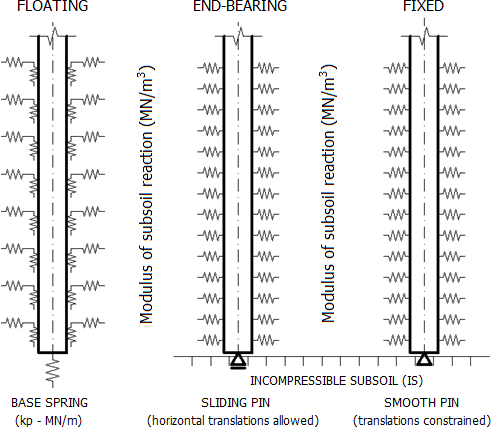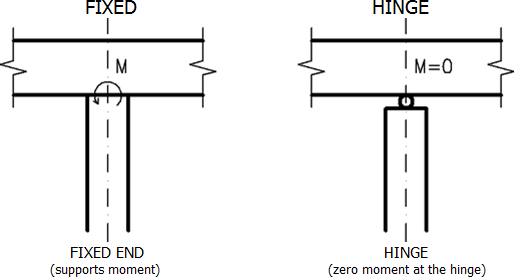Spring Method
The pile group is analyzed using the Finite Element Method. The pile cap is considered infinitely stiff. A general load is applied in the center of the cap and can be imported from an arbitrary program that performs a static analysis.
The piles analyzed according to figure:
 Modeling piles
Modeling piles
Four options to model piles are available in the frame "Settings":
- Floating piles - compute the stiffness of springs from soil parameters
- Floating piles - input the stiffness of springs
- Piles resting on the rock subgrade
- Piles fixed into the rock subgrade
Micropiles are always considered floating.
All options require inputting the "Horizontal modulus of subsoil reaction" characterizing the pile behavior in the transverse direction. Floating piles further require determining the stiffness of vertical springs. The program allows for back calculation of this stiffness from the available soil parameters and the typical load. They can also be inputted directly in the frame "Vertical springs".
Either hinge or fixed-type connection of a pile to the pile cap can be considered.
 Connecting pile to the pile-cap (selected in the frame "Settings")
Connecting pile to the pile-cap (selected in the frame "Settings")
The analysis of the structure is performed using the finite element method (FEM). Each pile is divided into ten elements. For each element the program defines the magnitude of horizontal and vertical springs. In comparison to a single pile, the stiffness of horizontal and vertical springs are further reduced for both the inner and outer piles - the horizontal stiffness is reduced by the coefficients equal to 0.5 and 0.25 for the outer and inner piles, respectively; the shear stiffness is reduced by the coefficients equal to 0.5 and 0.1 for the outer and inner piles, respectively. These reductions well represent the real behavior of a pile group. The springs at the pile-base and all springs in the micropile group analysis are not reduced.
In the case of strip foundation, the spring reduction is considered only in the direction of foundation width.